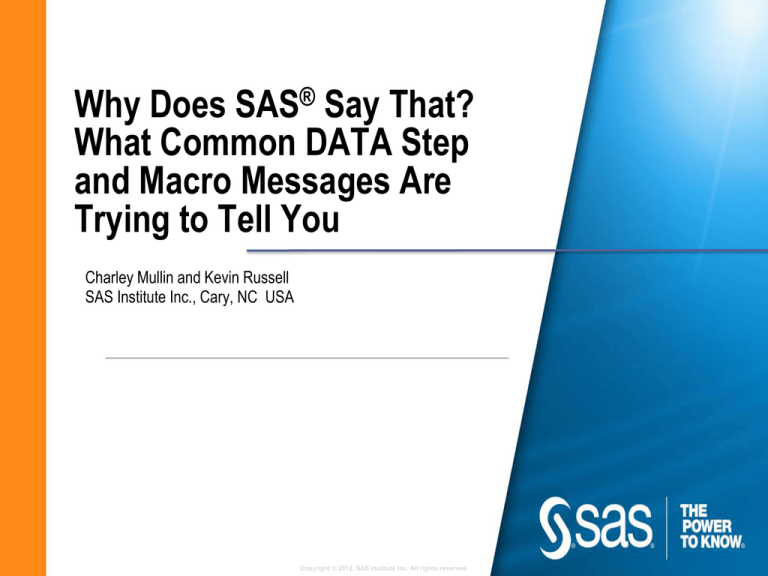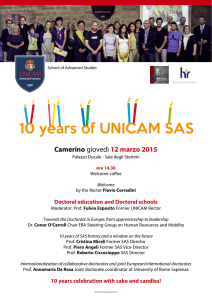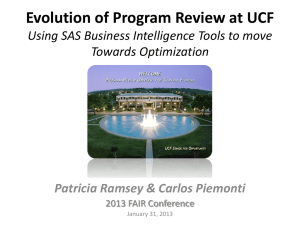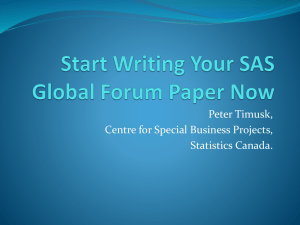
Why Does SAS® Say That?
What Common DATA Step
and Macro Messages Are
Trying to Tell You
Charley Mullin and Kevin Russell
SAS Institute Inc., Cary, NC USA
Copyright © 2012, SAS Institute Inc. All rights reserved.
Today You Will Learn to…
Better understand the SAS log
Debug your code more easily
Work more efficiently
2
Copyright © 2012, SAS Institute Inc. All rights reserved.
First, Let’s Discuss the DATA Step
The benefits of DATA step:
Gives you the ability to read external files
into SAS data sets
Enables you to manipulate data into a more
usable form
Enables you combine data from various
sources
And more…
3
Copyright © 2012, SAS Institute Inc. All rights reserved.
In the SAS Log, You Will Encounter:
Notes
Warnings
Errors
4
Copyright © 2012, SAS Institute Inc. All rights reserved.
Variables with Multiple Definitions
ERROR: Variable VAR1 has been defined as both
character and numeric.
data one;
input var1 $ var2;
datalines;
1 2
;
run;
data two;
input var1 var2;
datalines;
3 4
;
run;
data three;
merge one two;
by var1 var2;
run;
5
Copyright © 2012, SAS Institute Inc. All rights reserved.
Variables with Multiple Definitions (continued)
ERROR: Variable VAR1 has been defined as both
character and numeric.
data one;
set one(rename=(var1=temp));
var1=input(temp,??8.);
drop temp;
run;
data two;
set two(rename=(var1=temp));
var1=put(temp,8.);
drop temp;
run;
6
Copyright © 2012, SAS Institute Inc. All rights reserved.
Input to Concatenation Functions
NOTE: Argument 1 to function CATS at line N column X is invalid.
NOTE: Further warning from this call to CATS will be suppressed.
WARNING: In a call to the CATS function, the buffer allocated for the
result was not long enough to contain the concatenation of all
the arguments. The correct result would contain 1040
characters, but the actual result may either be truncated to
200 character(s) or be completely blank, depending on the
calling environment. The following note indicates the left-most
argument that caused truncation.
NOTE: Argument 1 to function CATS at line N column 6 is invalid.
7
Copyright © 2012, SAS Institute Inc. All rights reserved.
Input to Concatenation Functions (continued)
data final;
merge group1(rename=(results=r1))
group2(rename=(results=r2))
group3(rename=(results=r3));
results=cats(r1,r2,r3);
run;
data final;
merge group1(rename=(results=r1))
group2(rename=(results=r2))
group3(rename=(results=r3));
length results $ 1040;
results=cats(r1,r2,r3);
run;
8
Copyright © 2012, SAS Institute Inc. All rights reserved.
Arguments to the Function SUBSTR
NOTE: Invalid second argument to
function SUBSTR at line N column X.
NOTE: Invalid third argument to function
SUBSTR at line N column X.
9
Copyright © 2012, SAS Institute Inc. All rights reserved.
Arguments to the Function SUBSTR (continued)
In typical usage, the three arguments to the
SUBSTR function are:
The name of the variable from which to
extract characters
The position in the variable to start
extracting characters
The number of characters to extract
10
Copyright © 2012, SAS Institute Inc. All rights reserved.
Arguments to the Function SUBSTR (continued)
NOTE: Invalid second argument to function SUBSTR
at line N column X.
data lab_work;
infile datalines truncover;
input raw $char20.;
machine=substr(strip(raw),1,4);
test_id=substr(strip(raw),6,4);
results=substr(strip(raw),11,4);
datalines;
1234 5678
1234 5678 9012
;
run;
11
Copyright © 2012, SAS Institute Inc. All rights reserved.
Arguments to the Function SUBSTR (continued)
NOTE: Invalid second argument to function SUBSTR
at line N column X.
data lab_work;
infile datalines truncover;
input raw $char20.;
machine=substr(left(raw),1,4);
test_id=substr(left(raw),6,4);
results=substr(left(raw),11,4);
datalines;
1234 5678
1234 5678 9012
;
run;
12
Copyright © 2012, SAS Institute Inc. All rights reserved.
Arguments to the Function SUBSTR (continued)
NOTE: Invalid third argument to function SUBSTR at
line N column X.
data test;
date=‘24/04/2012’;
year=substr(date,7,10);
run;
data test;
date=‘24/04/2012’;
year=substr(date,7,4);
run;
13
Copyright © 2012, SAS Institute Inc. All rights reserved.
Automatic Variable Type Conversions
NOTE: Numeric values have been
converted to character values at the places
given by: (Line):(Column).
NOTE: Character values have been
converted to numeric values at the places
given by: (Line):(Column).
14
Copyright © 2012, SAS Institute Inc. All rights reserved.
Automatic Variable Type Conversions (continued)
NOTE: Numeric values have been converted to
character values at the places given by: (Line):(Column)
data test;
ssn=111223333;
first_three=substr(ssn,1,3);
run;
The SAS System
Obs
1
ssn
first_
three
111223333
proc print data=test;
run;
15
Copyright © 2012, SAS Institute Inc. All rights reserved.
Automatic Variable Type Conversions (continued)
NOTE: Numeric values have been converted to character
values at the places given by: (Line):(Column)
data test;
ssn=111223333;
first_three=substr(put(ssn,z9.),1,3);
run;
The SAS System
Obs
1
ssn
111223333
first_
three
111
proc print data=test;
run;
16
Copyright © 2012, SAS Institute Inc. All rights reserved.
Uninitialized Variable
NOTE: Variable FEMELE is uninitialized.
data two;
set one;
if sex=1 then gender=Femele;
run;
17
Copyright © 2012, SAS Institute Inc. All rights reserved.
Uninitialized Variable (continued)
SAS Log:
3652
3653
3654
3655
data two;
set one;
if sex=1 then gender=Femele;
run;
NOTE: Variable Femele is uninitialized.
18
Copyright © 2012, SAS Institute Inc. All rights reserved.
Uninitialized Variable (continued)
Correct syntax:
data two;
set one;
if sex=1 then gender=‘Female’;
run;
19
Copyright © 2012, SAS Institute Inc. All rights reserved.
Using a Function Name As an Array Name
NOTE: The array <name> has the same
name as a SAS-supplied or user-defined
function. Parentheses following this name
are treated as array references and not
function references.
20
Copyright © 2012, SAS Institute Inc. All rights reserved.
Using a Function Name As an Array Name
(continued)
SAS log:
43
44
data test;
array max(3) max1-max3 (80 90 70);
NOTE: The array max has the same name as a SAS-supplied or
user-defined function. Parentheses following this name are
treated as array references and not function references.
45
max_value=max(of max(*));
ERROR: Too many array subscripts specified for array max.
46
run;
NOTE: The SAS System stopped processing this step because
of errors.
21
Copyright © 2012, SAS Institute Inc. All rights reserved.
Using a Function Name As an Array Name
(continued)
data test;
array max(3) max1-max3 (80 90 70);
max_value=max(of max(*));
run;
data test;
array maxx(3) max1-max3 (80 90 70);
max_value=max(of maxx(*));
run;
22
Copyright © 2012, SAS Institute Inc. All rights reserved.
Now Let’s Discuss the Macro Facility
The macro facility allows you to extend
and customize your code and reduce
the amount of text you must enter.
23
Copyright © 2012, SAS Institute Inc. All rights reserved.
When Using the Macro Facility, Use These
System Options:
SYMBOLGEN
MPRINT
MLOGIC
24
Copyright © 2012, SAS Institute Inc. All rights reserved.
Masking Special Characters
ERROR: Macro function %substr has too many
arguments. The excess arguments will be ignored.
%let x=a,b,c;
%let y=%substr(&x,1,1);
%put &=y;
%let x=a,b,c;
%let y=%substr(a,b,c,1,1);
%put &=y;
25
Copyright © 2012, SAS Institute Inc. All rights reserved.
Masking Special Characters (continued)
Complete error in the SAS log:
189 %let x=a,b,c;
190 %let y=%substr(&x,1,1);
SYMBOLGEN: Macro variable X resolves to a,b,c
ERROR: Macro function %SUBSTR has too many arguments.
The excess arguments will be ignored.
ERROR: A character operand was found in the %EVAL function or
%IF condition where a numeric operand is required.
The condition was: b
ERROR: Argument 2 to macro function %SUBSTR is not a number.
ERROR: A character operand was found in the %EVAL function or
%IF condition where a numeric operand is required.
The condition was: c
ERROR: Argument 3 to macro function %SUBSTR is not a number.
191
&=y
%put &=y;
26
Copyright © 2012, SAS Institute Inc. All rights reserved.
Masking Special Characters (continued)
Corrected code:
%let x=a,b,c;
%let y=%substr(%bquote(&x),1,1);
%put &=y;
27
Copyright © 2012, SAS Institute Inc. All rights reserved.
Autocall Macros Used As Macro Functions
%CMPRES and %QCMPRES
%COMPSTOR
%DATATYP
%KVERIFY
%LEFT and %QLEFT
%LOWCASE and %QLOWCASE
%TRIM and %QTRIM
%VERIFY
28
Copyright © 2012, SAS Institute Inc. All rights reserved.
Autocall Macros Used As Macro Functions
(continued)
Example that illustrates a problem:
options mautosource sasautos=(‘c:\mymacs’);
%let x=%str(abc
);
%let y=%trim(&x);
29
Copyright © 2012, SAS Institute Inc. All rights reserved.
Autocall Macros Used As Macro Functions
(continued)
SAS log:
3
options mautosource sasautos=('c:\mymacs');
4
%let x=%str(abc
);
5
%let y=%trim(&x);
WARNING: Apparent invocation of macro TRIM not
resolved.
30
Copyright © 2012, SAS Institute Inc. All rights reserved.
Autocall Macros Used As Macro Functions
(continued)
Correct setting for the SASAUTOS system
option:
options mautosource sasautos=(sasautos, 'c:\mymacs');
%let x=%str(abc
);
%let y=%trim(&x);
31
Copyright © 2012, SAS Institute Inc. All rights reserved.
Using Macro Variables in Filenames
ERROR: Physical file does not exist, c:\class2011csv.
%let year=2011;
proc import
datafile="C:\class&year.csv"
dbms=csv
out=myclass
replace;
getnames=yes;
run;
32
Copyright © 2012, SAS Institute Inc. All rights reserved.
Using Macro Variables in Filenames (continued)
ERROR: Physical file does not exist, c:\class2011csv.
datafile=“c:\class2011csv”;
33
Copyright © 2012, SAS Institute Inc. All rights reserved.
Using Macro Variables in Filenames (continued)
ERROR: Physical file does not exist, c:\class2011csv.
Here is the correct syntax:
%let year=2011;
proc import datafile=“C:\class&year..csv”
dbms=csv
out=myclass
replace;
getnames=yes;
run;
34
Copyright © 2012, SAS Institute Inc. All rights reserved.
Referencing Stored Compiled Macros
ERROR: A LOCK IS NOT AVAILABLE FOR LIBREF.SASMACR.CATALOG.
35
Copyright © 2012, SAS Institute Inc. All rights reserved.
Referencing Stored Compiled Macros
(continued)
ERROR: A lock is not available for MYMACS.SASMACR.CATALOG.
libname mymacs ‘C:\macros’;
options mstored sasmstore=mymacs;
%macro test / store;
<code>;
%mend test;
%test
36
Copyright © 2012, SAS Institute Inc. All rights reserved.
Referencing Stored Compiled Macros
(continued)
SAS log:
NOTE: The SAS System was unable to open the
macro library referenced by the
SASMSTORE = libref MYMACS.
ERROR: A lock is not available for
MYMACS.SASMACR.CATALOG.
ERROR: A dummy macro will be compiled.
37
Copyright © 2012, SAS Institute Inc. All rights reserved.
Referencing Stored Compiled Macros
(continued)
38
Copyright © 2012, SAS Institute Inc. All rights reserved.
Invoking a Macro with Parameters
Error: More positional parameters found than
defined.
%macro test(vals);
%put &=vals;
%mend test;
%test(x,y,z)
39
Copyright © 2012, SAS Institute Inc. All rights reserved.
Invoking a Macro with Parameters (continued)
SAS log:
19
%macro test(vals);
20
%put &=vals;
21
%mend test;
22
%test(x,y,z)
MLOGIC(TEST): Beginning execution.
MLOGIC(TEST): Parameter VALS has value x
ERROR: More positional parameters found than
defined.
MLOGIC(TEST): Ending execution.
40
Copyright © 2012, SAS Institute Inc. All rights reserved.
Invoking a Macro with Parameters (continued)
Corrected code:
%macro test(vals);
%put &=vals;
%mend test;
%test(%str(x,y,z))
41
Copyright © 2012, SAS Institute Inc. All rights reserved.
Questions?
Support@SAS.com
(919) 677-8008
http://support.sas.com/techsup
42
Copyright © 2012, SAS Institute Inc. All rights reserved.









